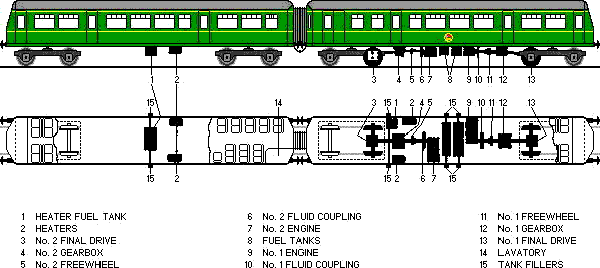DMU Technology - The Basics
What is a DMU and how does it work?
DMU is an abbreviation for Diesel Multiple Unit. It commonly covers diesel powered units with two types of transmission, mechanical (DMMUs) and hydraulic (DHMUs). Normally differentiated, vehicles with electric transmission are referred to as DEMUs which had particular ties with the Southern Region.
"Multiple"
Diesel Multiple Units, as the name implies, are designed to run in units (sometimes called sets) normally comprising powered & unpowered vehicles. There are many different formations possible, although the common arrangement being a 3-car set with two powered driving cars with an unpowered trailer car in the middle, or a 2-car set with one powered driving car and one unpowered driving trailer, although many other formations have been used. These units can be worked in multiple with other units with the same coupling code, up to a maximum of six power cars, depending on the control system design.
Cars, Railcars, Bubbles, Twins
We often refer to individual vehicles as 'cars', ie. 'power car' 'centre car' or 'trailer car', and 'railcar' is an alternate name for a DMU. Bubble car is a nickname for a single unit power car with cabs on both ends (glass on all sides giving it the name bubble) which could operate on it's own. A twin set would be a two-car set, particulary if it was a power twin formed of two power cars. Two-car sets formed of one power car and one driver trailer were commonly called driver-trailer sets. Three and four-car sets were also known as 'triples' and 'quads'.
Transmission
The transmission is the method that is used to take the power output from the diesel engine and make the wheels turn.
- Mechanical
- Uses a fluid flywheel, freewheel, gearbox and final drive coupled by cardan shafts.
- Hydraulic
- Uses a torque converter and final drive coupled by cardan shafts
- Electric
- Uses a generator and traction motors coupled by cables
The 'drive train' commonly refers to the line of components that transmits the power between the engine and the wheels.
| Manufacturer | Type | Power | Cylinders |
| AEC | 220 | 150hp | 6-cylinder |
| Leyland | 600 | 125hp | 6-cylinder |
| " | 680 | 150hp | 6-cylinder |
| Leyland Albion | 230hp | 6-cylinder | |
| Rolls Royce | C6 | 180hp | 6-cylinder |
| " | C8 | 238hp | 8-cylinder |
Engines
There were various types of engines used on mechanical and hydraulic vehicles as shown in the table. All engines were underfloor mounted, and were of the horizontal type. All power cars had two engines except the Cravens Class 112/113 power twin sets which had one on each power car (and in later years some 104/111 power cars were converted to one engine).
Mechanical Transmission
The general layout of the power unit, transmission, etc. on a driver-trailer set is shown below. No. 1 engine and transmission is always on the driver's left-hand side when sitting in the driver's seat, and No. 2 engine and transmission on the right-hand side.

Fixed to the output of the engine (7/9) is a fluid
coupling (6/10). This flywheel comprised of two halves and was filled with oil. The two halves
contain membranes, and the oil is forced outward between these so the input half turns the output side
and acts an an automatic clutch.
The output from the fluid coupling is connected to a cardan shaft fitted with a freewheel (5/11). This is a protection device that prevents the wheels rotating the engine, for example when going downhill.
The freewheel connects to the 4-speed gearbox (4/12). This epicyclic designed box allows ratios from 4.28/1 in 1st gear up to 1/1 (direct drive) in 4th.
The gearbox is connected by a cardan shaft to the final drive (3/13) mounted on the inner axle of the bogie. To allow for the pivoting of the bogies when around corners Hardy Spicer universal couplings were fitted to either ends of the shafts. On the final drive the drive was transmitted through one of two bevel pinions, selected according to the desired direction of travel.


